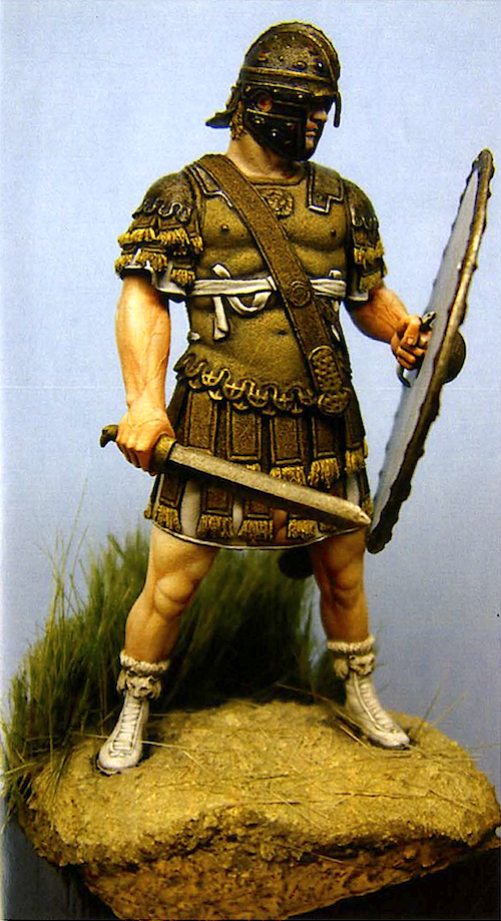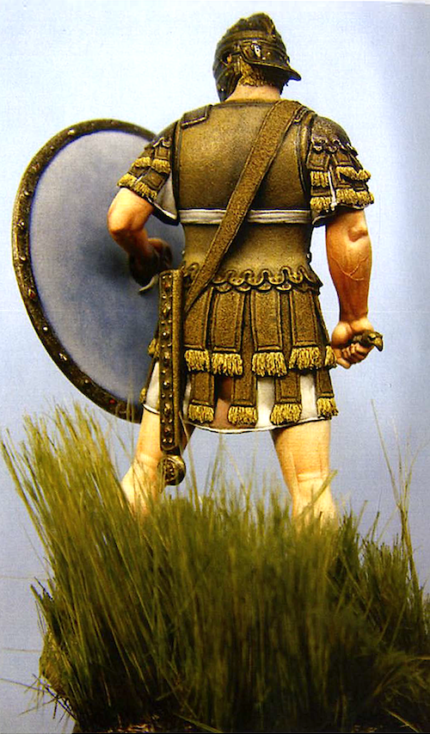Magister Militum

Later, the two were combined in the office of Magister Utruisque Militum or simply Magister Militum. From its beginnings, the recipients tended to be Romanised Germans, held in high regard for their ferocity and courage in battle. In fact, the army of this period was not really Roman at all, the majority being made up of Romanised Germans, migrant peoples who had crossed the Rhine and been allowed to settle on condition that they fought for Rome.



Remember to paint the arm prior to attaching fire shield.

Another superbly cast and sculpted figure from Pegaso

This figure comes in six crisply cast pieces, with minimal flash and well up to Pegaso’s usual standard. Being to 75mm scale, the figure offers a greater scope for an increased level of detail. This can be seen in the exquisitely well-sculpted ‘wolf cub’ boots and eagle-headed sword pommel; kudos to the sculptor Yury Serebriakov, a real talent in the making. It seems that Pegaso

have been listening to us painters, releasing of late many new 75mm figures and setting a new trend among other manufactures in this scale. There are many benefits to these slightly larger figures, 75mm being not so time consuming as a 90mm figure, not as eyestraining as a 54mm.
Anatomically the figure looks good to me, he has a very stocky powerful appearance. I remember recent discussions on Internet forums of him looking ‘pin-headed’, this feel is down to the bulky muscle cuirass and not any errors by the sculptor. Look at American football players and you will see what I mean.
50/50 mix of acrylic Yellow Ochre+Yellow.
Base-coat–
Oil colour Venetian Red+Ochre+Cadrnium Yellow.
First Highlight–
Basecoat+Naples Yellow+Titanium White.
First Shadow –
Venetian Red.
Second Highlight–
First highlight+ Titanium White.
Deepest Shadow –
Lamp Black.
Final Highlight–
Second highlight+Titanium White.
Acrylic White + Yellow Ochre 80/20% mix.
Basecoat–
Naples Yellow.
Shadow–
Burnt Umber.
Deepest Shadow–
Sepia
The hair is painted in my usual way of texturing oil paint to resemble tousled hair then, when dry, shaded using washes of Sepia and Burnt Umber. I chose a Blonde hair colour as I wanted to hint at his Germanic origins.
The muscle cuirass as mentioned earlier seems to be slightly incorrect for the time frame of this figure, because of this I decided upon a very worn appearance, hinting that it might have been handed down from father to son.
I began by giving the leather areas an undercoat of Andrea acrylic Yellow ochre (20%) and Yellow (80%). When dry, Sepia was employed as a basecoat, diluted with a little thinner.
Using a stippling/dabbing motion the undercoat is gradually revealed, leaving a dotty and crazed look to the paint surface, not unlike worn leather. Shadows were painted using Sepia and for stitch lines and deep shadows Lamp Black was employed. When dry I added painted dots and simulated cuts in a random fashion using Ochre acrylic paint.



Undercoat – acrylic Blue.
Base coat – Permanent Blue.
First Highlight – Titanium White+Naples+ Yellow+Permanent Blue.
First Shadow – Permanent Blue.
Second Highlight – First highlight+Titanium White.
Final Highlight – Titanium White.
Starting with an undercoat of light blue acrylic then a base-coat of Permanent Blue, an oil colour mix of Titanium White, Naples Yellow and Permanent Blue was used to lighten the shield base-coat until a washed out blue had been achieved.
This is a similar technique to my ‘white approach’, starting with a dark base coat and highlighting up until I reach the colour and shade I’m looking for.
When all was dry I began work on the eagle motif by sketching out the eagle shape with acrylic paints, then base coating it with Venetian Red + Black.
The first highlights were Venetian Red and shadows in Lamp Black; final highlights were Venetian Red + Naples Yellow.



These are superbly well rendered by the sculptor and are a real credit to his abilities. Beginning with a Sepia base coat over a white acrylic undercoat the hide of the wolf cub boots were painted with my usual method for white. On the wolves’ heads I had decided on a ‘flea bitten’ look , which I tried to achieve by painting furrows and peaks into a neat Titanium White base coat.
When dry I shaded the pelts with Burnt Umber and Lamp Black, and a wash of Yellow Ochre oil paint was flowed over the thoroughly dried boots to age and to dirty them.
Helmet and metal area’s
Shadows are neat Sepia painted around rivets and join lines to help raise the detail, highlights are gold acrylic. When all had dried a heavily-thinned coat of
Lacquin was used to reinforce the metallic look to the helmet. The brightly coloured jewels are just balls of neat oil paint, highlighted when dry with a catch light of neat Titan.
Undercoat – acrylic white Base coat – Sepia First Highlight – white First Shadow – Sepia
Second Highlight – white Deepest Shadow – black Final Highlight – white
The white tunic and the sash were painted in my usual method of progressively highlighting a Sepia basecoat with Titanium White until the desired tone had been reached.
The Tyrian Purple (Roman Red) stripe which indicates the wearer’s high rank is a mix of Venetian Red with a dab of Permanent Blue, then shadowed with Lamp Black and later re-highlighted with the base coat plus Naples Yellow.
Second Highlight – Naples Yellow
The base supplied in the kit offers an excellent and secure mount for the figure, but is a little simple on detail. After pinning and gluing to the display base with ‘5- minute’ epoxy glue, the areas left around the kit base and the display plinth were filled in with Milliput then, whilst still wet, blended and textured with a rough stone to resemble a dry river bed.
When dry I base coated with Sepia, then stippled with Naples Yellow until it looked like earth. A tonal wash of Yellow Ochre was used later to reinforce the earthy look.
The grass is made from the bristles of an old wallpaper paste brush, cut down to size and then attached to the groundwork using super glue.
When dry I washed the grass with Sap Green/Sepia oil paint and whilst still wet I flattened and tangled it to indicate wind effects. Later, some unpainted bristles were scattered on to the groundwork and attached with white glue.


Pegaso figures are available from Historex Agents
Please visit Hardy Tempest’s Facebook page to see some of his wonderful work: https://www.facebook.com/hardytempestsminiatureart/


